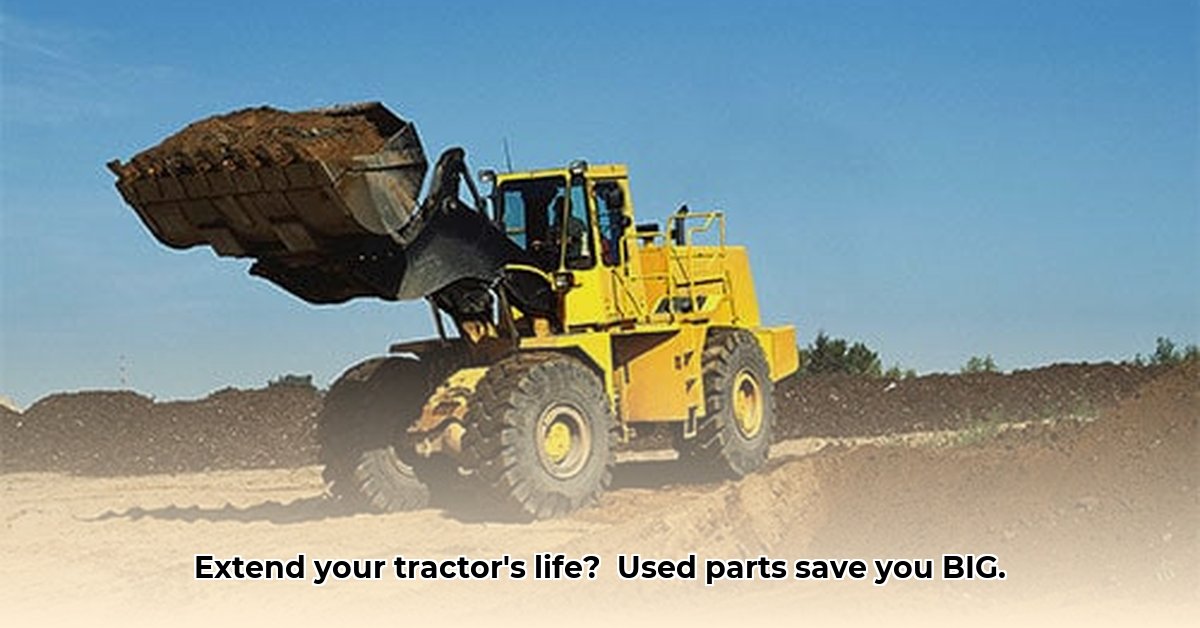
Extending the Life of Your Equipment: A Sustainable Approach to Farming in Kansas
Finding the right tractor parts in Kansas can be challenging, but utilizing used parts offers significant financial and environmental advantages. This article explores how Kansas farmers can successfully navigate the used tractor parts market, maximizing savings while minimizing environmental impact. We'll cover sourcing strategies, quality control measures, and the importance of sustainable farming practices. For additional resources, check out this helpful guide on tractor part sourcing.
Understanding the Used Parts Market: A Greener Alternative
The used tractor parts market provides a sustainable alternative to purchasing new parts. By repurposing existing components, farmers reduce the demand for new manufacturing, lowering carbon emissions and conserving resources. However, this market's inherent variability in part quality necessitates a cautious approach. This includes carefully evaluating suppliers and rigorously inspecting parts.
Choosing the Right Kansas Tractor Parts: A Practical Guide
Before purchasing used tractor parts, follow these crucial steps:
Supplier Reputation: Research potential suppliers thoroughly. Check online reviews, assess their business history, and consider their length of operation. (A longer history often correlates with increased reliability.)
Comprehensive Part Inspection: Request detailed images and videos of the part. Don't hesitate to ask specific questions regarding its condition and any potential defects. A thorough inspection is paramount.
Warranty Assurance: Insist on a warranty. A supplier's willingness to offer a warranty demonstrates confidence in their product's quality and provides recourse in case of failure.
Part Traceability: Seek suppliers who can provide information on the part's origin, refurbishment process, and handling. Transparency builds trust and bolsters sustainability efforts.
Cost-Benefit Analysis: Compare the cost of a used part to a new one, considering potential repair costs if the used part fails. A slightly more expensive, higher-quality used part might ultimately be more cost-effective in the long run.
Sustainable Farming Practices: A Holistic Approach
Many Kansas farmers are adopting sustainable practices. Using used tractor parts significantly contributes to this effort. This approach integrates financial and environmental benefits, enhancing the long-term health and sustainability of your farming operation.
Here are key elements of a sustainable farming strategy that leverages used parts:
Preventative Maintenance: Regular equipment maintenance, including preventative measures, extends its operational lifespan and reduces the need for frequent part replacements. This proactive approach saves time and money.
Inventory Management: Maintaining a detailed inventory of parts helps farmers anticipate future needs, prioritize essential replacements, and manage parts procurement efficiently.
Sustainable Supplier Partnerships: Supporting suppliers committed to ethical practices and environmental responsibility establishes a mutually beneficial collaboration and promotes a broader positive impact.
Navigating the Regulatory Landscape: Challenges and Opportunities
Currently, the used tractor parts market lacks stringent regulations. This lack of clarity creates uncertainty about the future, with potential for new rules impacting both suppliers and farmers. Increased transparency and safety standards would benefit the entire industry. Expert opinions suggest that clearer regulations are likely to emerge within the next few years.
The Future of Kansas Tractor Parts: A Growing and Essential Market
The market for used and remanufactured tractor parts is expanding rapidly. This presents exceptional opportunities for long-term cost savings and environmental sustainability. Through informed decision-making, sustainable practices, and advocating for improved regulations, we can create a more environmentally friendly future for Kansas agriculture.
Risk Assessment and Mitigation
| Risk Factor | Likelihood | Impact | Mitigation Strategy |
|---|---|---|---|
| Part Quality Issues | Medium | High | Thorough inspection; warranties; detailed supplier information |
| Supply Chain Disruptions | Medium | Medium | Diverse suppliers; strong partnerships; backup plans |
| Lack of Transparency | High | Medium | Increased traceability; potentially blockchain technology |
| Environmental Impact Concerns | Low | Medium | Life-cycle assessments; environmentally conscious recycling |
This assessment indicates that while risks exist, many can be effectively mitigated through careful planning and informed decision-making.
How to Find Reliable Used Tractor Parts for Sustainable Farming
Key Takeaways:
- Utilizing reliable used tractor parts offers significant cost savings and promotes sustainability for Kansas farmers.
- The used parts market requires due diligence, careful inspection, and a comprehensive supplier evaluation process.
- Successful sourcing involves a combination of online research, networking within the local farming community, and direct contact with salvage yards.
- Preventative maintenance and robust inventory management practices support both farm efficiency and environmental responsibility.
Sourcing Strategies: A Step-by-Step Guide
Finding reliable used tractor parts requires a multi-pronged approach:
Online Search: Utilize online platforms like Farm Net Services (https://www.farmnetservices.com/salvage/KANSAS_FARM_MACHINERY_EQUIPMENT_SALVAGE_&_USED_TRACTOR_PARTS/16-0.html) to locate potential suppliers and parts. Be specific in your searches.
Local Networking: Leverage your local network. Farmers and local repair shops often possess valuable information about reliable used parts suppliers.
Salvage Yard Contacts: Directly contact salvage yards to inquire about part availability and condition. Thorough inspections are essential before purchase.
Part Reconditioning: Consider reconditioning used parts to extend their lifespan, reducing waste and saving money.
Mitigating Risks: Ensuring Quality and Reliability
The inherent variability of used parts requires mitigation strategies:
- Rigorous Inspection: Perform a meticulous inspection before purchase to identify any signs of wear or damage.
- Multiple Supplier Comparisons: Obtain quotations and compare part conditions from multiple suppliers to ensure you're obtaining the best value.
- Supplier Due Diligence: Verify the reputation and reliability of potential suppliers before making a purchase.
Long-Term Sustainability: A Commitment to the Future
Implementing sustainable practices is essential. Preventative maintenance extends equipment lifespan, reducing the need for replacements and minimizing waste. Invest time in developing a comprehensive inventory management system to track and manage your parts efficiently. This integrated approach, combining financial and environmental stewardship, ensures a successful and sustainable future for your operation.